Holographic Gratings for Slow-Neutron Optics
Abstract
:1. Introduction
2. Prerequisites
2.1. Hologram Recording
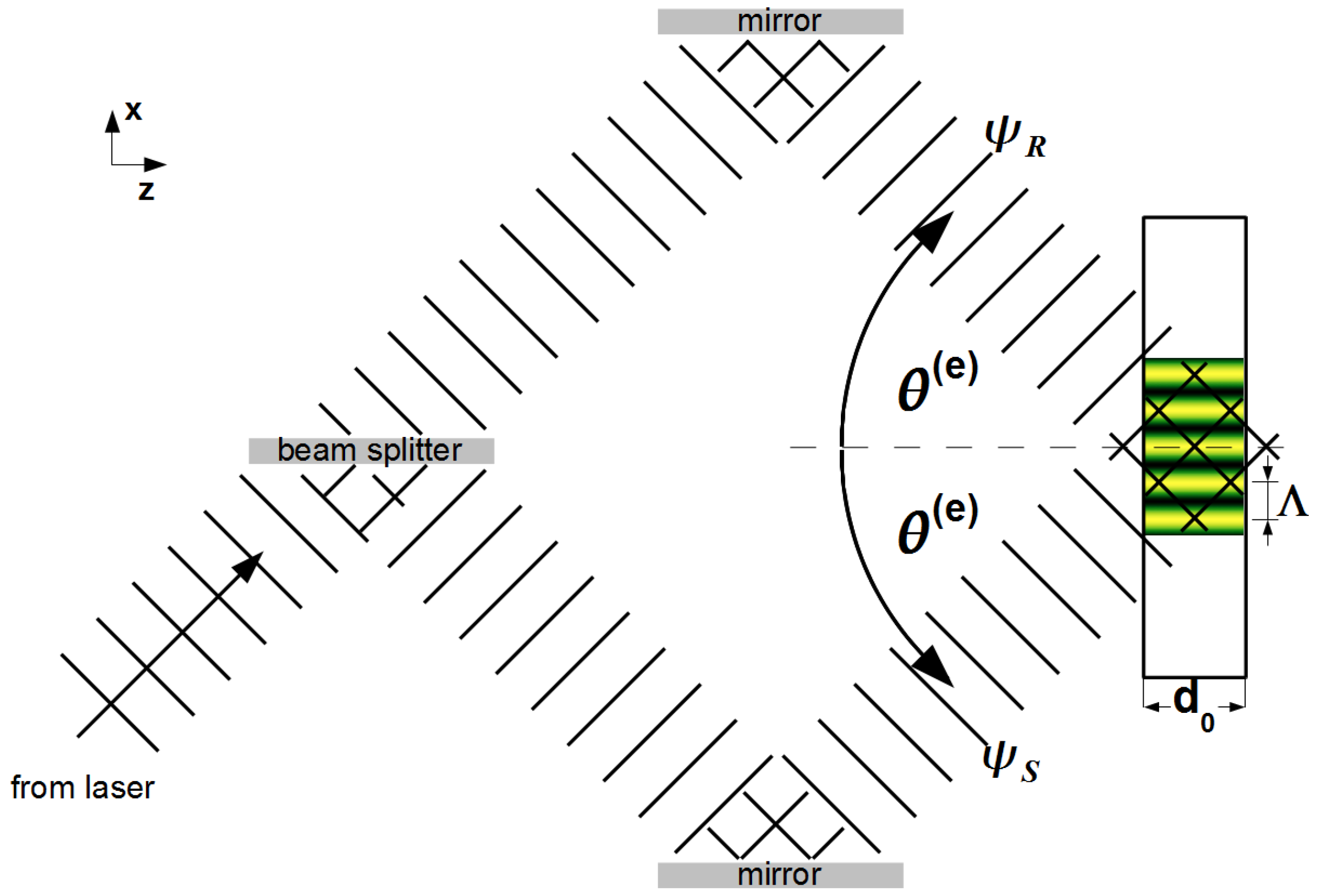
2.2. Neutron Diffraction
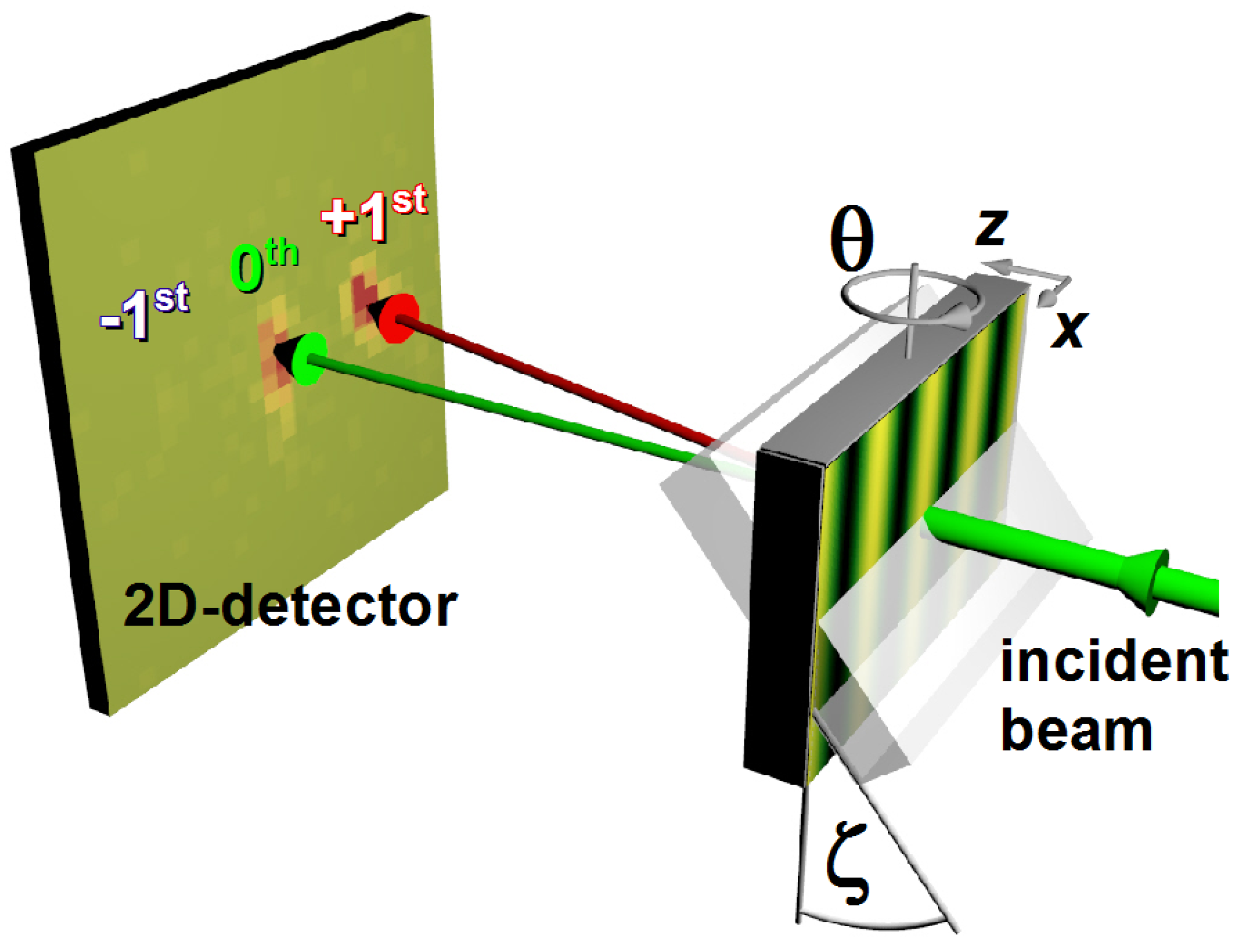
2.3. Diffraction Efficiency


3. Nanoparticle-Polymer Composite gratings

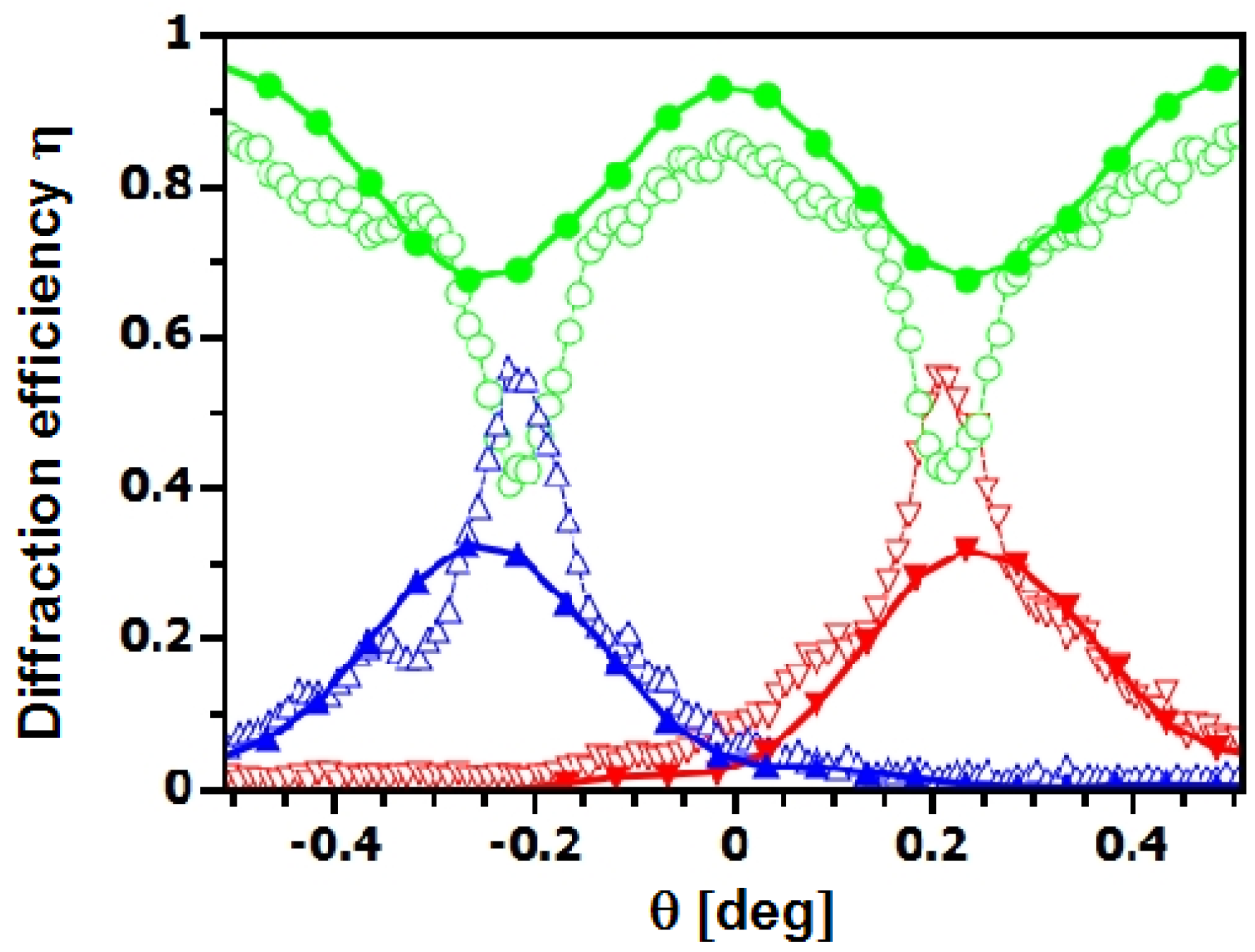


4. (Poly)methylmethacrylate Gratings

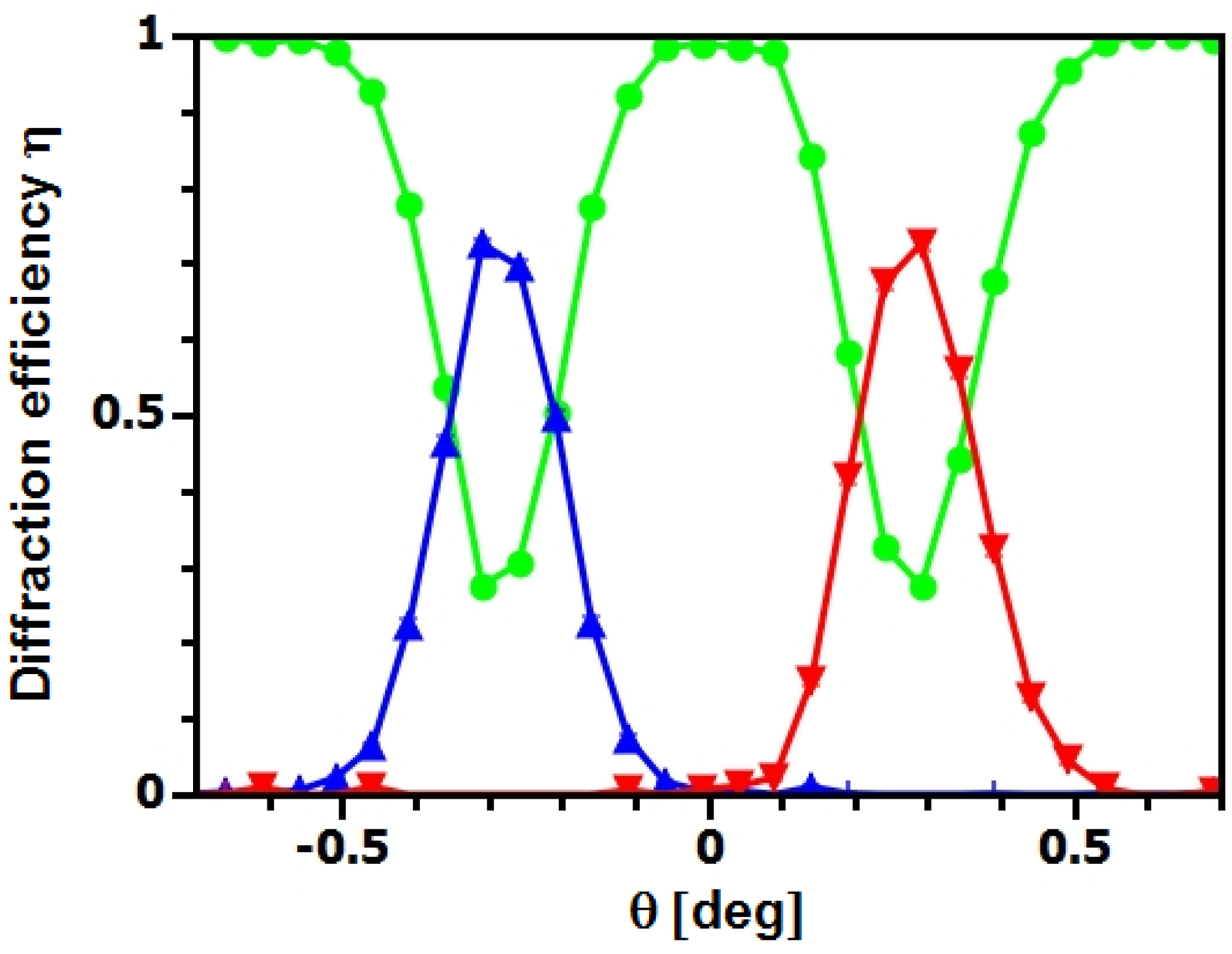
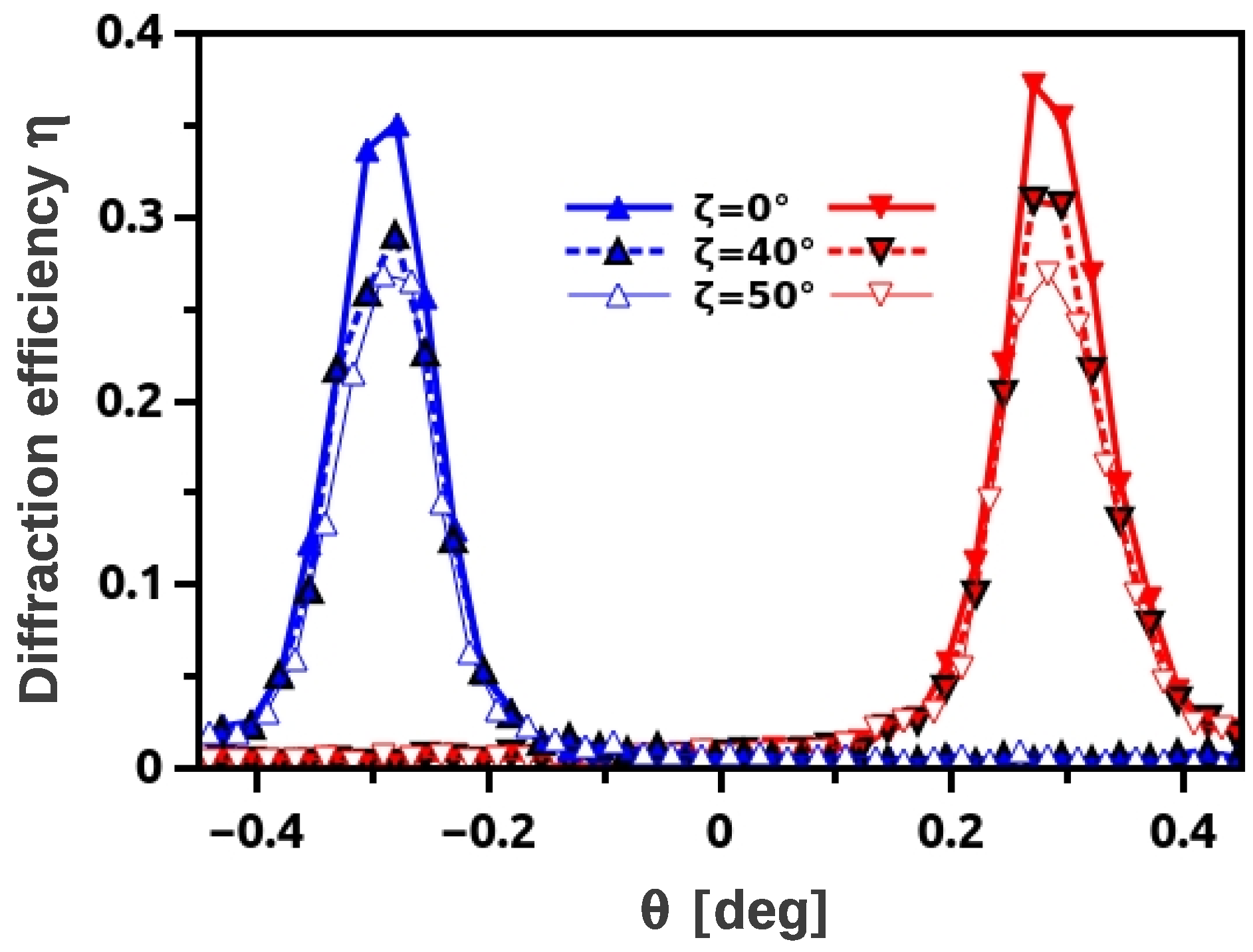
5. Holographic Polymer-Dispersed Liquid Crystal gratings

6. Perspectives and Potential Applications
6.1. Pendellösung Oscillation
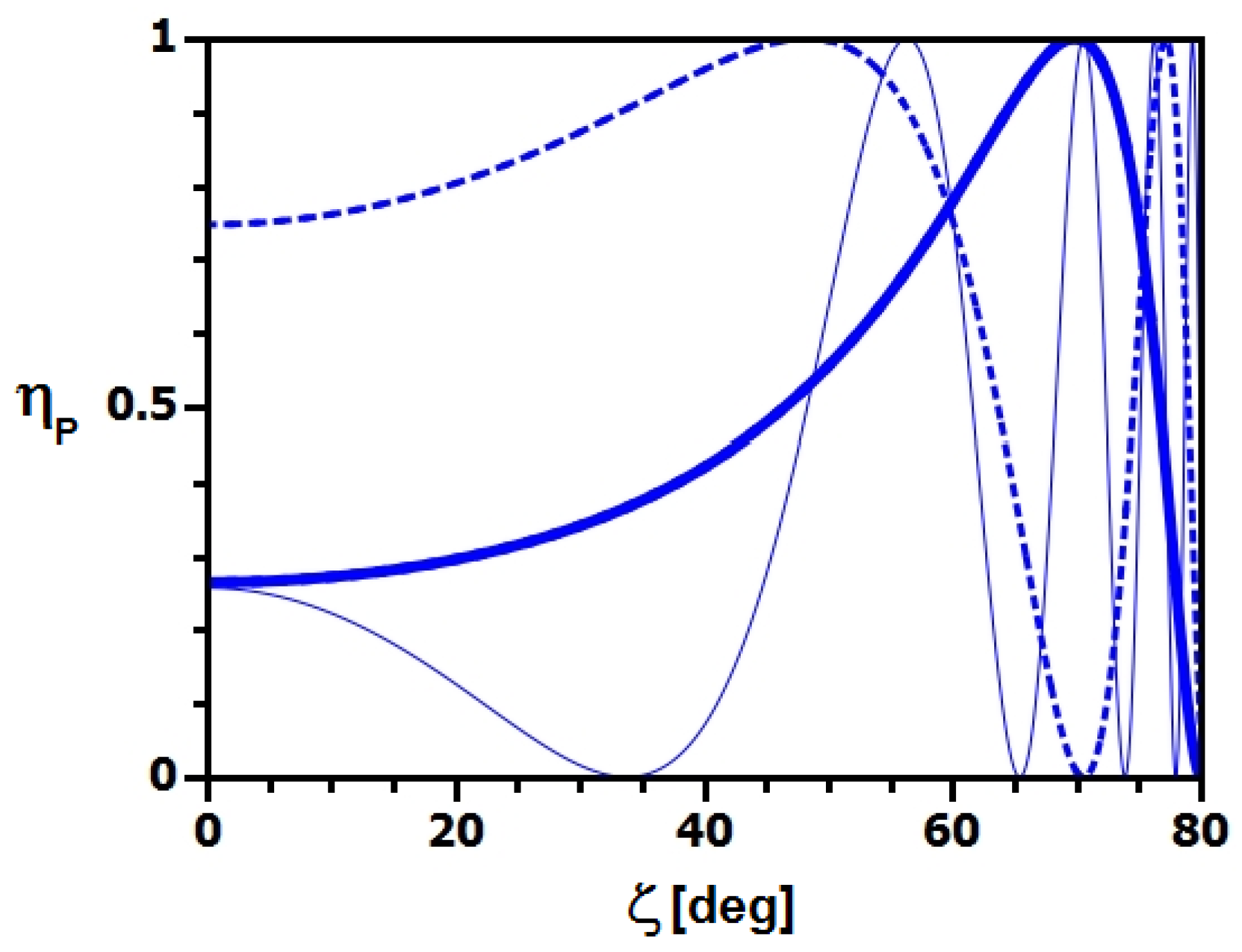
6.2. Grating Collimators
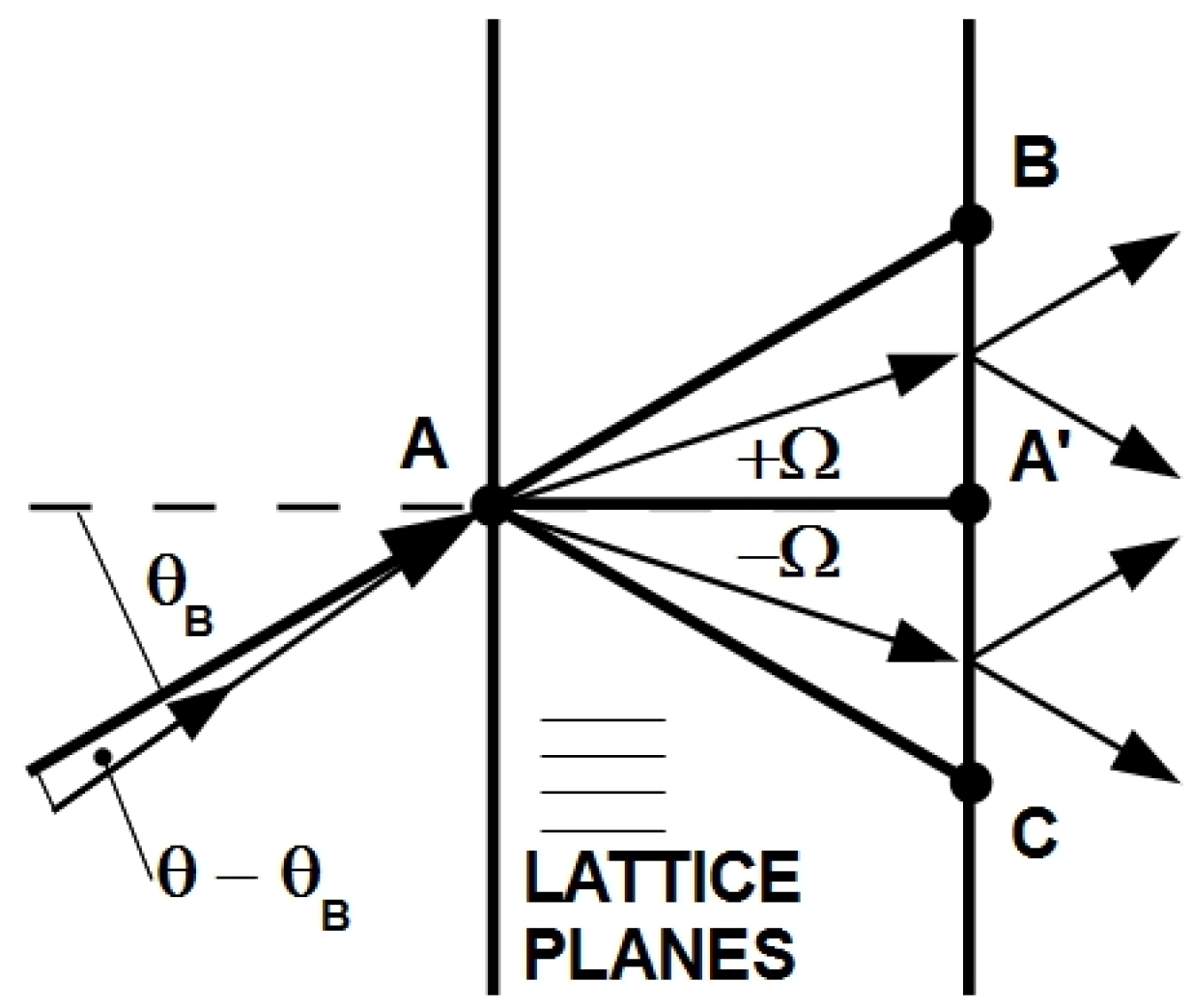
6.3. Mach-Zehnder Interferometer
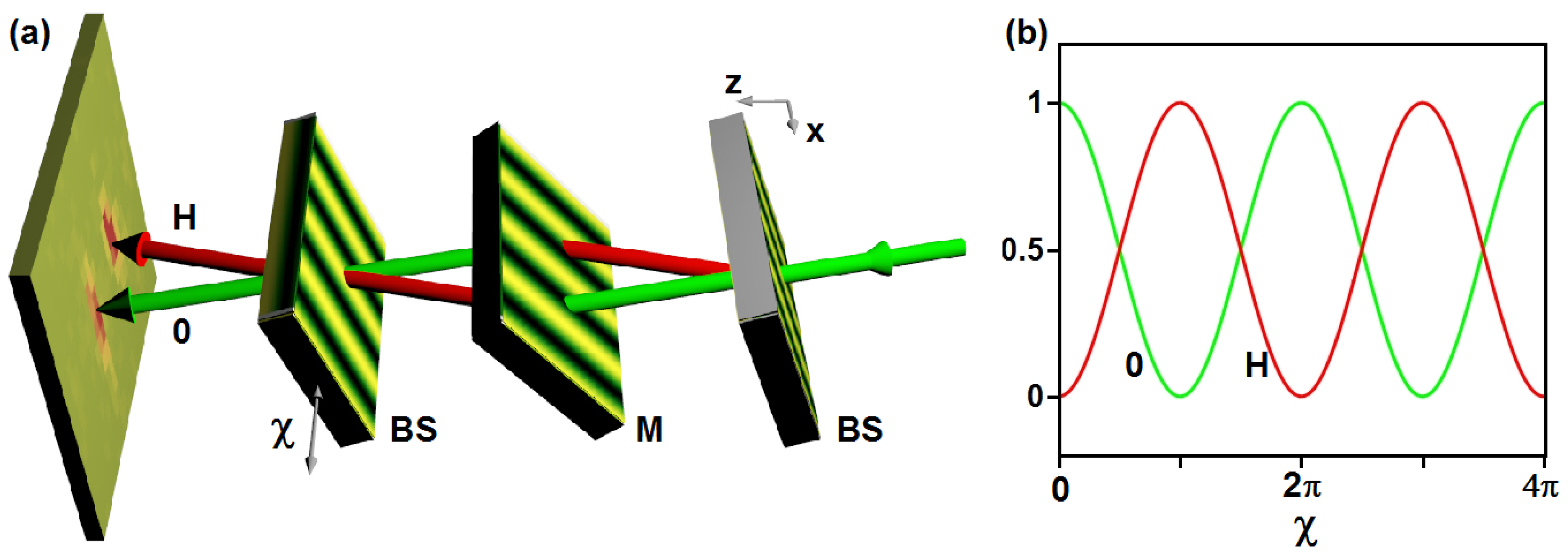
6.4. Polarizing Beam Splitters

6.5. Absorption Gratings

7. Conclusions and Outlook
| Sample name | Material | Λ[ nm] | Thickness [μm] | λ[nm] | Comments | Reference | ||
|---|---|---|---|---|---|---|---|---|
| G1 | d-PMMA | 380 | 1.5 | 0 | 0.50 | D22, ILL (2003) | [66] | |
| G2 | d-PMMA | 380 | 1.5 | 0 | 0.58 | D22, ILL (2003) | [66] | |
| 1 | 0.26 | |||||||
| 1.1 | 0.30 | |||||||
| 1.5 | 0.50 | |||||||
| 1.7 | 0.57 | |||||||
| 1.9 | 0.65 | |||||||
| 2.1 | 0.70 | |||||||
| 2.3 | 0.76 | |||||||
| 2.6 | 0.81 | |||||||
| 0.19 | S18, ILL (2009) | - | ||||||
| 3.8 | 0.75 | PF2, ILL (2010) | Figure 10 | |||||
| 0.36 | PF2, ILL (2012) | Figure 11 | ||||||
| 40 | 0.30 | |||||||
| 50 | 0.27 | |||||||
| G3 | d-PMMA | 380 | 1.5 | 0 | 0.05 | D22, ILL (2003) | [66] | |
| 10g | H-PDLC | 1200 | 50 | 1.16 | 0 | 0.03 | SANS-2, GeNF (2005) | [72] |
| 1.96 | 0.11 | |||||||
| 10f | H-PDLC | 1200 | 50 | 1.16 | 0 | 0.03 | SANS-2, GeNF (2005) | [89] |
| 1.96 | 0.11 | - | ||||||
| 4.4 | 0.31 | PF2, ILL (2012) | Figure 12 | |||||
| 29w | H-PDLC | 560 | 50 | 1.16 | 0 | 0.009 | SANS-2, GeNF (2008) | [32] |
| 29e | H-PDLC | 1000 | 100 | 1.16 | 0 | 0.005 | SANS-2, GeNF (2008) | - |
| S#2 (NP2007) | 20 vol% SiO2 NP | 1000 | 50 | 0.19 | 0 | S18, ILL (2009) | [31] | |
| 1.7 | 0 | 0.07 | SANS I, PSI (2010) | [46] | ||||
| 45 | 0.11 | - | ||||||
| 58 | 0.20 | [46] | ||||||
| S#4 (NP2007) | 20 vol% ZrO2 NP | 1000 | 48 | 0.19 | 0 | S18, ILL (2009) | - | |
| 1.16 | 0 | 0.01 | SANS I, PSI (2010) | [59] | ||||
| S#1 (NP2010b) | 34 vol% SiO2 NP | 1000 | 46 | 1.7 | 0 | 0.08 | SANS I, PSI (2010) | [46] |
| S#3 (NP2010b) | 34 vol% SiO2 NP | 500 | 53 | 1.7 | 0 | 0.03 | SANS I, PSI (2010) | - |
| S#5 (NP2010b) | 20 vol% SiO2 NP | 1000 | 96 | 1.7 | 0 | 0.19 | SANS I, PSI (2010) | [46] |
| 56 | 0.29 | -”-, 3-port beam splitter | [85] | |||||
| S#7 (NP2010b) | 20 vol% SiO2 NP | 500 | 101 | 1.7 | 0 | 0.06 | SANS I, PSI (2010) | [46] |
| 66 | 0.11 | - | ||||||
| 2 | 64 | 0.50 | -”-, beam splitter | [46,59] | ||||
| 3.8 | 0 | 0.25 | PF2, ILL (2010) | [46] | ||||
| 3.8 | 43 | 0.31 | ||||||
| 3.8 | 60 | 0.61 | ||||||
| 3.8 | 65 | 0.83 | ||||||
| S#9 (NP2010b) | 20 vol% SiO2 NP | 1000 | 186 | 3.8 | 0 | 0.50 | PF2, ILL (2012), strong | - |
| 3.8 | 45 | 0.52 | Figure 4 | |||||
| 3.8 | 60 | 0.35 | - | |||||
| S#11 (NP2010b) | 20 vol% SiO2 NP | 500 | 180 | 1.7 | 0 | 0.04 | SANS I, PSI (2010) | [46] |
| S#1 (NP2011b) | 20 vol% SiO2 NP | 500 | 86 | 4.5 | 0 | 0.20 | PF2, ILL (2011) | Figure 5 |
| S#2 (NP2011b) | 25 vol% SiO2 NP | 500 | 71 | 4.5 | 0 | 0.20 | PF2, ILL (2011) | Figure 5 |
| S#10 (NP2011b) | 20 vol% SiO2 NP | 500 | 136 | 4.5 | 0 | 0.08 | PF2, ILL (2011), fsf | - |
| S#11 (NP2011b) | 25 vol% SiO2 NP | 500 | 115 | 4.4 | 0 | 0.12 | PF2, ILL (2011), fsf | - |
| S#6 (NP2011b) | 20 vol% SiO2 NP | 500 | 96 | 4.4 | 0 | 0.20 | PF2, ILL (2011) | Figure 7 |
| 0.20 | -”-, fsf | |||||||
| S#7 (NP2011b) | 20 vol% SiO2 NP | 500 | 115 | 4.4 | 0 | 0.25 | PF2, ILL (2011), fsf | - |
| 4.1 | 70 | 0.90 | -”-, mirror | [60] |
Acknowledgments
References
- Willis, B.T.M.; Carlile, C.J. Experimental Neutron Scattering; Oxford University Press: Oxford, UK, 2009. [Google Scholar]
- Furrer, A.; Mesot, J.; Strässle, T. Neutron Scattering in Condensed Matter Physics; World Scientific: Singapore, 2009. [Google Scholar]
- Rauch, H.; Werner, S.A. Neutron Interferometry; Clarendon Press: Oxford, UK, 2000. [Google Scholar]
- Dubbers, D.; Schmidt, M.G. The neutron and its role in cosmology and particle physics. Rev. Mod. Phys. 2011, 83, 1111–1171. [Google Scholar] [CrossRef]
- European Spallation Source. Available online: http://www.ess-scandinavia.eu (accessed on 18 September 2012).
- Sears, V.F. Neutron Optics; Oxford University Press: Oxford, UK, 1989. [Google Scholar]
- Hasegawa, Y.; Loidl, R.; Baron, M.; Badurek, G.; Rauch, H. Off-diagonal geometric phase in a neutron interferometer experiment. Phys. Rev. Lett. 2001, 87, 070401:1–070401:4. [Google Scholar] [CrossRef] [PubMed]
- Rauch, H.; Lemmel, H.; Baron, M.; Loidl, R. Measurement of a confinement induced neutron phase. Nature 2002, 417, 630–632. [Google Scholar] [CrossRef] [PubMed]
- Hasegawa, Y.; Loidl, R.; Badurek, G.; Baron, M.; Rauch, H. Violation of a bell-like inequality in single-neutron interferometry. Nature 2003, 425, 45–48. [Google Scholar] [CrossRef] [PubMed]
- Pushin, D.A.; Arif, M.; Huber, M.G.; Cory, D.G. Measurements of the vertical coherence length in neutron interferometry. Phys. Rev. Lett. 2008, 100, 250404:1–250404:4. [Google Scholar] [CrossRef] [PubMed]
- Huber, M.G.; Arif, M.; Black, T.C.; Chen, W.C.; Gentile, T.R.; Hussey, D.S.; Pushin, D.A.; Wietfeldt, F.E.; Yang, L. Precision measurement of the n-3He incoherent scattering length using neutron interferometry. Phys. Rev. Lett. 2009, 102, 200401:1–200401:4. [Google Scholar] [CrossRef] [PubMed]
- Bartosik, H.; Klepp, J.; Schmitzer, C.; Sponar, S.; Cabello, A.; Rauch, H.; Hasegawa, Y. Experimental test of quantum contextuality in neutron interferometry. Phys. Rev. Lett. 2009, 103, 040403:1–040403:4. [Google Scholar] [CrossRef] [PubMed]
- Pushin, D.A.; Huber, M.G.; Arif, M.; Cory, D.G. Experimental realization of decoherence-free subspace in neutron-interferometry. Phys. Rev. Lett. 2011, 107, 150401:1–150401:4. [Google Scholar] [CrossRef] [PubMed]
- Ioffe, A.I.; Zabiyakin, V.S.; Drabkin, G.M. Test of a diffraction grating neutron interferometer. Phys. Lett. 1985, 111, 373–375. [Google Scholar] [CrossRef]
- Gruber, M.; Eder, K.; Zeilinger, A.; Gähler, R.; Mampe, W. A phase-grating interferometer for very cold neutrons. Phys. Lett. A 1989, 140, 363–367. [Google Scholar] [CrossRef]
- Van der Zouw, G.; Weber, M.; Felber, J.; Gähler, R.; Geltenbort, P.; Zeilinger, A. Aharonov-Bohm and gravity experiments with the very-cold-neutron interferometer. Nucl. Instrum. Methods A 2000, 440, 568–574. [Google Scholar] [CrossRef]
- Funahashi, H.; Ebisawa, T.; Haseyama, T.; Hino, M.; Masaike, A.; Otake, Y.; Tabaru, T.; Tasaki, S. Interferometer for cold neutrons using multilayer mirrors. Phys. Rev. A 1996, 54, 649–651. [Google Scholar] [CrossRef] [PubMed]
- Seki, Y.; Uda, J.; Funahashi, H.; Kitaguchi, M.; Hino, M.; Otake, Y.; Taketani, K.; Shimizu, H.M. Demonstration of optical thickness measurement using multilayer cold neutron interferometer. J. Phys. Conf. Ser. 2012, 340, 012039:1–012039:5. [Google Scholar] [CrossRef]
- Pfeiffer, F.; Grünzweig, C.; Bunk, O.; Frei, G.; Lehmann, E.; David, C. Neutron phase imaging and tomography. Phys. Rev. Lett. 2006, 96, 215505:1–215505:4. [Google Scholar] [CrossRef] [PubMed]
- Strobl, M.; Grünzweig, C.; Hilger, A.; Manke, I.; Kardjilov, N.; David, C.; Pfeiffer, F. Neutron dark-field tomography. Phys. Rev. Lett. 2008, 101, 123902:1–123902:4. [Google Scholar] [CrossRef] [PubMed]
- Grünzweig, C.; Pfeiffer, F.; Bunk, O.; Donath, T.; Kühne, G.; Frei, G.; Dierolf, M.; David, C. Design, fabrication, and characterization of diffraction gratings for neutron phase contrast imaging. Rev. Sci. Instrum. 2008, 79, 053703:1–053703:6. [Google Scholar] [CrossRef] [PubMed]
- Grünzweig, C.; Hils, T.; Mühlbauer, S.; Ay, M.; Lorenz, K.; Georgii, R.; Gähler, R.; Böni, P. Multiple small angle neutron scattering: A new two-dimensional ultrasmall neutron scattering technique. Appl. Phys. Lett. 2007, 91, 203504:1–203504:3. [Google Scholar] [CrossRef]
- Yamada, M.; Iwashita, Y.; Kanaya, T.; Ichikawa, M.; Tongu, H.; Kennedy, S.; Shimizu, H.; Mishima, K.; Yamada, N.; Hirota, K.; Carpenter, J.; Lal, J.; Andersen, K.; Geltenbort, P.; Guerard, B.; Manzin, G.; Hino, M.; Kitaguchi, M.; Bleuel, M. The performance of magnetic lens for focusing VCN-SANS. Nucl. Instrum. Methods A 2011, 634, S156–S160. [Google Scholar] [CrossRef]
- Ashkin, A.; Boyd, G.D.; Dziedzic, J.M.; Smith, R.G.; Ballmann, A.A.; Levinstein, A.A.; Nassau, K. Optically-induced refractive index inhomogeneities in LiNbO3 and LiTaO3. Appl. Phys. Lett. 1966, 9, 72–74. [Google Scholar] [CrossRef]
- Rupp, R.A.; Hehmann, J.; Matull, R.; Ibel, K. Neutron diffraction from photoinduced gratings in a PMMA matrix. Phys. Rev. Lett. 1990, 64, 301–302. [Google Scholar] [CrossRef] [PubMed]
- Fally, M. The photo-neutronrefractive effect. Appl. Phys. B 2002, 75, 405–426. [Google Scholar] [CrossRef]
- Kohlbrecher, J.; Wagner, W. The new SANS instrument at the Swiss spallation source SINQ. J. Appl. Crystallogr. 2000, 33, 804–806. [Google Scholar] [CrossRef]
- Institut Laue-Langevin. The ILL Yellow Book; Institut Laue-Langevin: Grenoble, France, 2008. [Google Scholar]
- Kogelnik, H. Coupled wave theory for thick hologram gratings. Bell Syst. Tech. J. 1969, 48, 2909–2947. [Google Scholar] [CrossRef]
- Gaylord, T.K.; Moharam, M.G. Thin and thick gratings: Terminology clarification. Appl. Opt. 1981, 20, 3271–3273. [Google Scholar] [CrossRef] [PubMed]
- Klepp, J.; Pruner, C.; Ellabban, M.A.; Tomita, Y.; Lemmel, H.; Rauch, H.; Fally, M. Neutron optical gratings from nanoparticle-polymer composites. Nucl. Instrum. Methods A 2011, 634, S59–S62. [Google Scholar] [CrossRef]
- Fally, M.; Bichler, M.; Ellabban, M.A.; Drevenšek-Olenik, I.; Pruner, C.; Eckerlebe, H.; Pranzas, K.P. Diffraction gratings for neutrons from polymers and holographic polymer-dispersed liquid crystals. J. Opt. A: Pure Appl. Opt. 2009, 11, 024019:1–024019:8. [Google Scholar] [CrossRef]
- Suzuki, N.; Tomita, Y.; Kojima, T. Holographic recording in TiO2 nanoparticle-dispersed methacrylate photopolymer films. Appl. Phys. Lett. 2002, 81, 4121–4123. [Google Scholar] [CrossRef]
- Suzuki, N.; Tomita, Y. Silica-nanoparticle-dispersed methacrylate photopolymers with net diffraction efficiency near 100 percent. Appl. Opt. 2004, 43, 2125–2129. [Google Scholar] [CrossRef] [PubMed]
- Tomita, Y.; Suzuki, N.; Chikama, K. Holographic manipulation of nanoparticle distribution morphology in nanoparticle-dispersed photopolymers. Opt. Lett. 2005, 30, 839–841. [Google Scholar] [CrossRef] [PubMed]
- Suzuki, N.; Tomita, Y.; Ohmori, K.; Hidaka, M.; Chikama, K. Highly transparent ZrO2 nanoparticle-dispersed acrylate photopolymers for volume holographic recording. Opt. Express 2006, 14, 12712–12719. [Google Scholar] [CrossRef] [PubMed]
- Sakhno, O.V.; Goldenberg, L.M.; Stumpe, J.; Smirnova, T.N. Surface modified ZrO2 and TiO2 nanoparticles embedded in organic photopolymers for highly effective and UV-stable volume holograms. Nanotechnology 2007, 18, 105704:1–105704:7. [Google Scholar] [CrossRef]
- Nakamura, T.; Nozaki, J.; Tomita, Y.; Ohmori, K.; Hidaka, M. Holographic recording sensitivity enhancement of ZrO2 nanoparticle-polymer composites by hydrogen donor and acceptor agents. J. Opt. A 2009, 11, 024010:1–024010:7. [Google Scholar] [CrossRef]
- Sakhno, O.V.; Goldenberg, L.M.; Stumpe, J.; Smirnova, T.N. Effective volume holographic structures based on organic-inorganic photopolymer nanocomposites. J. Opt. A 2009, 11, 024013:1–024013:13. [Google Scholar] [CrossRef]
- Hata, E.; Tomita, Y. Order-of-magnitude polymerization-shrinkage suppression of volume gratings recorded in nanoparticle-polymer composites. Opt. Lett. 2010, 35, 396–398. [Google Scholar] [CrossRef] [PubMed]
- Fally, M.; Ellabban, M.A.; Rupp, R.A.; Fink, M.; Wolfsberger, J.; Tillmanns, E. Characterization of parasitic gratings in LiNbO3. Phys. Rev. B 2000, 61, 15778–15784. [Google Scholar] [CrossRef]
- Ellabban, M.A.; Fally, M.; Uršič, H.; Drevenšek-Olenik, I. Holographic scattering in photopolymer-dispersed liquid crystals. Appl. Phys. Lett. 2005, 87, 151101:1–151101:3. [Google Scholar] [CrossRef]
- Imlau, M.; Fally, M.; Weisemoeller, T.; Schaniel, D.; Herth, P.; Woike, T. Holographic light scattering in centrosymmetric sodium nitroprusside upon generation of light-induced metastable states. Phys. Rev. B 2006, 73, 205113:1–205113:9. [Google Scholar] [CrossRef]
- Suzuki, N.; Tomita, Y. Holographic scattering in SiO2 nanoparticle-dispersed photopolymer films. Appl. Opt. 2007, 46, 6809–6814. [Google Scholar] [CrossRef] [PubMed]
- Uchida, N. Calculation of diffraction efficiency in hologram gratings attenuated along the direction perpendicular to the grating vector. J. Opt. Soc. Am. 1973, 63, 280–287. [Google Scholar] [CrossRef]
- Klepp, J.; Pruner, C.; Tomita, Y.; Plonka-Spehr, C.; Geltenbort, P.; Ivanov, S.; Manzin, G.; Andersen, K.H.; Kohlbrecher, J.; Ellabban, M.A.; Fally, M. Diffraction of slow neutrons by holographic SiO2 nanoparticle-polymer composite gratings. Phys. Rev. A 2011, 84, 013621:1–013621:7. [Google Scholar] [CrossRef]
- Sippel, D.; Kleinstück, K.; Schulze, G.E.R. Pendellösungs-Interferenzen mit thermischen neutronen an Si-Einkristallen. Phys. Lett. 1965, 14, 174–175. [Google Scholar] [CrossRef]
- Shull, C.G. Observation of pendellösung fringe structure in neutron diffraction. Phys. Rev. Lett. 1968, 21, 1585–1589. [Google Scholar] [CrossRef]
- Batterman, B.W.; Cole, H. Dynamical diffraction of X rays by perfect crystals. Rev. Mod. Phys. 1964, 36, 681–717. [Google Scholar] [CrossRef]
- Rauch, H.; Petrascheck, D. Dynamical neutron diffraction and its application. In Neutron Diffraction; Dachs, H., Ed.; Springer-Verlag: Berlin, Germany, 1978; Chapter 9; pp. 303–351. [Google Scholar]
- Moharam, M.G.; Gaylord, T.K. Rigorous coupled-wave analysis of planar-grating diffraction. J. Opt. Soc. Am. 1981, 71, 811–818. [Google Scholar] [CrossRef]
- Kato, N.; Lang, A.R. A study of pendellösung fringes in X-ray diffraction. Acta Cryst. 1959, 12, 787–794. [Google Scholar] [CrossRef]
- Graf, H.A.; Schneider, J.R. Pendellösung intensity-beat measurement with 0.0392- and 0.0265-Åγ radiation in silicon. Phys. Rev. B 1986, 34, 8629–8638. [Google Scholar] [CrossRef]
- Savo, S.; Di Gennaro, E.; Miletto, C.; Andreone, A.; Dardano, P.; Moretti, L.; Mocella, V. Pendellösung effect in photonic crystals. Opt. Express 2008, 16, 9097–9105. [Google Scholar] [CrossRef] [PubMed]
- Moran, J.M.; Kaminow, I.P. Properties of holographic gratings photoinduced in polymethyl methacrylate. Appl. Opt. 1973, 12, 1964–1970. [Google Scholar] [CrossRef] [PubMed]
- Calvo, M.L.; Cheben, P.; Martínez-Matos, O.; del Monte, F.; Rodrigo, J.A. Experimental detection of the optical pendellösung effect. Phys. Rev. Lett. 2006, 97, 084801:1–084801:4. [Google Scholar] [CrossRef] [PubMed]
- Kunze, S.; Dürr, S.; Rempe, G. Bragg scattering of slow atoms from a standing light wave. Europhys. Lett. 1996, 34, 343–348. [Google Scholar] [CrossRef]
- Somenkov, V.A.; Shilstein, S.Sh.; Belova, N.E.; Utemisov, K. Observation of dynamical oscillations for neutron scattering by Ge crystals using the inclination method. Solid State Commun. 1978, 25, 593–595. [Google Scholar] [CrossRef]
- Fally, M.; Klepp, J.; Tomita, Y.; Nakamura, T.; Pruner, C.; Ellabban, M.A.; Rupp, R.A.; Bichler, M.; Drevenšek-Olenik, I.; Kohlbrecher, J.; Eckerlebe, H.; Lemmel, H.; Rauch, H. Neutron optical beam splitter from holographically structured nanoparticle-polymer composites. Phys. Rev. Lett. 2010, 105, 123904:1–123904:4. [Google Scholar] [CrossRef] [PubMed]
- Klepp, J.; Pruner, C.; Tomita, Y.; Mitsube, K.; Geltenbort, P.; Fally, M. Mirrors for slow neutrons from holographic nanoparticle-polymer free-standing film-gratings. Appl. Phys. Lett. 2012, 100, 214104:1–214104:3. [Google Scholar] [CrossRef]
- Nesvizhevsky, V.V.; Cubitt, R.; Lychagin, E.; Muzychka, A.; Nekhaev, G.; Pignol, G.; Protasov, K.; Strelkov, A. Application of diamond nanoparticles in low-energy neutron physics. Materials 2010, 3, 1768–1781. [Google Scholar] [CrossRef]
- Matull, R.; Rupp, R.A.; Hehmann, J.; Ibel, K. Neutron diffraction by laser-generated volume phase gratings. Z. Phys. B 1990, 81, 365–369. [Google Scholar] [CrossRef]
- Matull, R.; Eschkötter, P.; Rupp, R.A.; Ibel, K. Perfect crystallike gratings for cold neutrons. Europhys. Lett. 1991, 15, 133–137. [Google Scholar] [CrossRef]
- Havermeyer, F.; Lyuksyutov, S.F.; Rupp, R.A.; Eckerlebe, H.; Staron, P.; Vollbrandt, J. Nondestructive resolution of higher harmonics of light-induced volume gratings in PMMA with cold neutrons. Phys. Rev. Lett. 1998, 80, 3272–3275. [Google Scholar] [CrossRef]
- Schellhorn, U.; Rupp, R.A.; Breer, S.; May, R.P. The first neutron interferometer built of holographic gratings. Physica B 1997, 234–236, 1068–1070. [Google Scholar] [CrossRef]
- Pruner, C.; Fally, M.; Rupp, R.A.; May, R.P.; Vollbrandt, J. Interferometer for cold neutrons. Nucl. Instrum. Methods A 2006, 560, 598–605. [Google Scholar] [CrossRef]
- Sutherland, R.L.; Natarajan, L.V.; Tondiglia, V.P. Bragg gratings in an acrylate polymer consisting of periodic polymer-dispersed liquid-crystal planes. Chem. Mater. 1993, 5, 1533–1538. [Google Scholar] [CrossRef]
- Bunning, T.J.; Natarajan, L.V.; Tondiglia, V.P.; Sutherland, R.L. Holographic polymer-dispersed liquid crystals (H-PDLCs). Annu. Rev. Mater. Sci. 2000, 30, 83–115. [Google Scholar] [CrossRef]
- Bowley, C.C.; Crawford, G.P. Diffusion kinetics of formation of holographic polymer-dispersed liquid crystal display materials. Appl. Phys. Lett. 2000, 76, 2235–2237. [Google Scholar] [CrossRef]
- Drevenšek-Olenik, I.; Fally, M.; Ellabban, M.A. Temperature dependence of optical anisotropy of holographic polymer-dispersed liquid crystal transmission gratings. Phys. Rev. E 2006, 74, 021707:1–021707:10. [Google Scholar] [CrossRef] [PubMed]
- Drevenšek-Olenik, I.; Jazbinšek, M.; Sousa, M.E.; Fontecchio, A.K.; Crawford, G.P.; Čopič, M. Structural transitions in holographic polymer-dispersed liquid crystals. Phys. Rev. E 2004, 69, 051703:1–051703:10. [Google Scholar] [CrossRef] [PubMed]
- Fally, M.; Drevenšek-Olenik, I.; Ellabban, M.A.; Pranzas, K.P.; Vollbrandt, J. Colossal light-induced refractive-index modulation for neutrons in holographic polymer-dispersed liquid crystals. Phys. Rev. Lett. 2006, 97, 167803:1–167803:4. [Google Scholar] [CrossRef] [PubMed]
- Baumann, J.; Gähler, R.; Kalus, J.; Mampe, W. Experimental limit for the charge of the neutron. Phys. Rev. D 1988, 37, 3107–3112. [Google Scholar] [CrossRef]
- Plonka-Spehr, C.; Kraft, A.; Iaydjiev, P.; Klepp, J.; Nesvizhevsky, V.V.; Geltenbort, P.; Lauer, T. An optical device for ultra-cold neutrons—Investigation of systematic effects and applications. Nucl. Instrum. Methods A 2010, 618, 239–247. [Google Scholar] [CrossRef]
- Fally, M.; Klepp, J.; Tomita, Y. An experimental study on the validity of diffraction theories for off-Bragg replay of volume holographic gratings. Appl. Phys. B 2012, 108, 89–96. [Google Scholar] [CrossRef]
- Zeilinger, A.; Shull, C.G. Magnetic field effects on dynamical diffraction of neutrons by perfect crystals. Phys. Rev. B 1979, 19, 3957–3962. [Google Scholar] [CrossRef]
- Kikuta, S.; Ishikawa, I.; Kohra, K.; Hoshino, S. Studies on dynamical diffraction phenomena of neutrons using properties of wave fan. J. Phys. Soc. Jpn. 1975, 39, 471–478. [Google Scholar] [CrossRef]
- Summhammer, J. Testing energy quantization at the level of 100 kHz by neutron crystal diffraction. Phys. Rev. A 1996, 54, 3155–3164. [Google Scholar] [CrossRef] [PubMed]
- Lemmel, H.; Wagh, A.G. Phase shifts and wave-packet displacements in neutron interferometry and a nondispersive, nondefocusing phase shifter. Phys. Rev. A 2010, 82, 033626:1–033626:9. [Google Scholar] [CrossRef]
- Wagner, W.; Kohlbrecher, J. Small-angle neutron scattering. In Modern Techniques for Characterizing Magnetic Materials; Zhu, Y., Ed.; Kluwer Academic Publishers: Dortrecht, The Netherlands, 2005; Chapter 2. [Google Scholar]
- Gyergyek, S.; Huskic, M.; Makovec, D.; Drofenik, M. Superparamagnetic nanocomposites of iron oxide in a polymethyl methacrylate matrix synthesized by in situ polymerization. Colloids Surf. A Physicochem. Eng. Asp. 2008, 317, 49–55. [Google Scholar] [CrossRef]
- Avdeev, M.V.; Dubois, E.; Meriguet, G.; Wandersman, E.; Garamus, V.M.; Feoktystov, A.V.; Perzynski, R. Small angle neutron scattering analysis of a water-based magnetic fluid with charge stabilization: Contrast variation and scattering of polarized neutrons. J. Appl. Cryst. 2009, 42, 1009–1019. [Google Scholar] [CrossRef]
- Liu, X.; Tomita, Y.; Oshima, J.; Chikama, K.; Matsubara, K.; Nakashima, T.; Kawai, T. Holographic assembly of semiconductor CdSe quantum dots in polymer for volume Bragg grating structures with diffraction efficiency near 100%. Appl. Phys. Lett. 2009, 95, 261109:1–261109:3. [Google Scholar] [CrossRef]
- Liu, X.; Adachi, Y.; Tomita, Y.; Oshima, J.; Nakashima, T.; Kawai, T. High-order nonlinear optical response of a polymer nanocomposite film incorporating semiconductor CdSe quantum dots. Opt. Express 2012, 20, 13457–13469. [Google Scholar] [CrossRef] [PubMed]
- Klepp, J.; Tomita, Y.; Pruner, C.; Kohlbrecher, J.; Fally, M. Three-port beam splitter for slow neutrons using holographic nanoparticle-polymer diffraction gratings. Appl. Phys. Lett. 2012, 101, 154104:1–154104:3. [Google Scholar] [CrossRef]
- Borrmann, G. Die absorption von röntgenstrahlen im falle der interferenz (In German). Z. Phys. 1950, 127, 297–323. [Google Scholar] [CrossRef]
- Knowles, J.W. Anomalous absorption of slow neutrons and X-rays in nearly perfect single crystals. Acta Cryst. 1956, 9, 61–69. [Google Scholar] [CrossRef]
- Oberthaler, M.K.; Abfalterer, R.; Bernet, S.; Schmiedmayer, J.; Zeilinger, A. Atom waves in crystals of light. Phys. Rev. Lett. 1996, 77, 4980–4983. [Google Scholar] [CrossRef] [PubMed]
- Drevenšek-Olenik, I.; Ellabban, M.A.; Fally, M.; Pranzas, K.P.; Vollbrandt, J. Neutron diffraction from holographic polymer-dispersed liquid crystals. Proc. SPIE 2007, 6587, 65870F:1–65870F:6. [Google Scholar]
© 2012 by the authors; licensee MDPI, Basel, Switzerland. This article is an open access article distributed under the terms and conditions of the Creative Commons Attribution license (http://creativecommons.org/licenses/by/3.0/).
Share and Cite
Klepp, J.; Pruner, C.; Tomita, Y.; Geltenbort, P.; Drevenšek-Olenik, I.; Gyergyek, S.; Kohlbrecher, J.; Fally, M. Holographic Gratings for Slow-Neutron Optics. Materials 2012, 5, 2788-2815. https://doi.org/10.3390/ma5122788
Klepp J, Pruner C, Tomita Y, Geltenbort P, Drevenšek-Olenik I, Gyergyek S, Kohlbrecher J, Fally M. Holographic Gratings for Slow-Neutron Optics. Materials. 2012; 5(12):2788-2815. https://doi.org/10.3390/ma5122788
Chicago/Turabian StyleKlepp, Juergen, Christian Pruner, Yasuo Tomita, Peter Geltenbort, Irena Drevenšek-Olenik, Saso Gyergyek, Joachim Kohlbrecher, and Martin Fally. 2012. "Holographic Gratings for Slow-Neutron Optics" Materials 5, no. 12: 2788-2815. https://doi.org/10.3390/ma5122788
APA StyleKlepp, J., Pruner, C., Tomita, Y., Geltenbort, P., Drevenšek-Olenik, I., Gyergyek, S., Kohlbrecher, J., & Fally, M. (2012). Holographic Gratings for Slow-Neutron Optics. Materials, 5(12), 2788-2815. https://doi.org/10.3390/ma5122788






